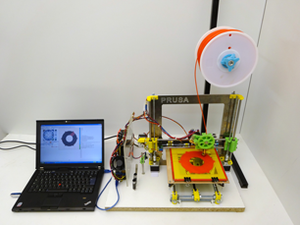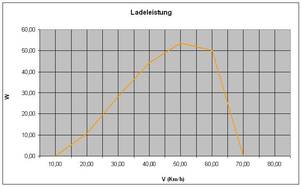Version 5.2

Goal in the development of the Reprap-Windturbine was to develop a wind turbine which can be produced and reproduced for the most part with a conventional 3D printer .... without lathe, milling machine or welding machine. The Reprap- Windturbine is not a toy or demonstration model, but a fully satisfying, robust machine for the permanent generation of electrical energy.
The result of 2 years of development, 4 series of prototypes, hundreds of test drives on a specially equipped test vehicle and numerous calculations and laboratory tests is the Reprap-Windturbine V5.2.
Specifications
- 3-blade rotor D = 0.84 m
- Storm protection by stall of the rotor at wind speed > 50 Km/h
- Power limitation by stall (save temperature boundary of the generator)
- Generator brake by shorting the phases
- Triphase neodym magnet alternator. Maximum charging power 55W (continuous output!)
- 3-phase collector ring
- 12V battery charging
General
The Reprap wind turbine has been developed for the reproduction. For this purpose, a 3D printer, an electric hand drill and conventional hand tools are needed. The detailed construction manual provides information on the theoretical fundamentals and provides a step by step with over 160 colored images through the entire construction of this wind turbine. Special skills are not required for this. All required STL- files for the reproduction of the Reprap-Windturbine are provided, of course.
The Generator

The generator is a modern, dual ball-bearing, 3-phase alternator with 9 coils and 24 neodym magnets. It has a maximum continuous power rating of 55W and is dimensioned that it also serves as an additional storm brake. For the winding of the coils, a device was developed, which is also 3D-printed and, of course, it is part of the construction manual. All required materials are to obtain world wide. Sources of supply are part of the construction manual.
The Collectorring

The Reprap wind turbine has a 3-phase collector ring. It is built of springs from a ball pen, a piece of copper pipe from the plumber, carbon brushes from a cordless screwdriver and.... 3D printed parts, of course. To adjust the right spring tension a 3D printed spring scale is used.
The Rotorblades

The rotor blades are cut out of thin aluminum sheet with the help of a paper template. For bending the airfoil in the right shape a 3D printed protractor is used. These rotor blades are very easy and fast to build, extremely robust and from an aerodynamic point of view better than one would expect.
